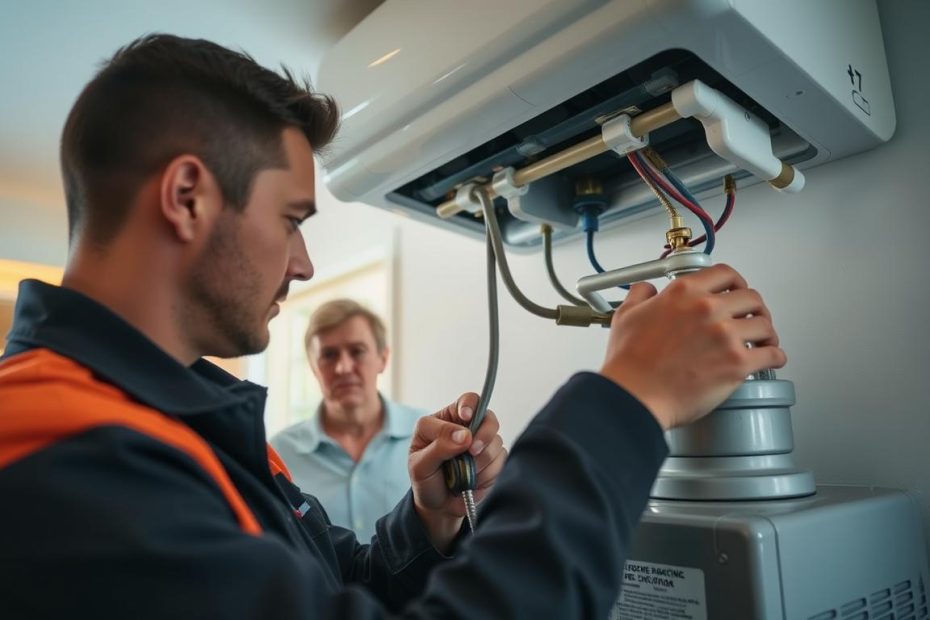A Freon leak can be a significant issue for homeowners, potentially causing damage to your HVAC system and impacting your indoor air quality.
When a leak occurs, it’s crucial to identify and address it promptly to avoid costly repairs and ensure your home remains comfortable.
We will guide you through the signs of a Freon leak and provide steps to take for HVAC repair, helping you to identify the issue and get it fixed quickly.
By understanding the causes and consequences of a leak, you’ll be better equipped to maintain your HVAC system and keep your home safe and comfortable.
How to Identify a Freon Leak in Your House
Identifying a refrigerant leak early can save you from costly repairs and potential health risks. A Freon leak can manifest in various ways, making it essential to be vigilant about the signs.
Common Signs of Refrigerant Leaks
Several indicators can signal a Freon leak in your home. These include:
- Increased electricity bills due to reduced HVAC efficiency
- Ice buildup on refrigerant lines or the evaporator coil
- Hissing or bubbling sounds near the HVAC system
- Water leakage or condensation around the air conditioning unit
Noticing any of these signs should prompt you to investigate further.
| Signs | Description |
|---|---|
| Increased Electricity Bills | A sudden spike in your energy consumption could indicate that your HVAC system is working harder due to a Freon leak. |
| Ice Buildup | Visible ice on the refrigerant lines or evaporator coil is a clear indicator of a potential leak. |
| Hissing Sounds | A hissing noise near the HVAC system can signify escaping refrigerant. |
Using Your Senses to Detect Leaks
Before using any specialized tools, you can use your senses to detect potential leaks. Look for oil residue around the HVAC system, as Freon can carry oil out with it, leaving visible traces. You can also feel for cold spots or unusual temperature fluctuations around the refrigerant lines.
“A simple yet effective method to detect leaks is by using soapy water. Apply it to the suspected area; bubbles will form if there’s a leak.”
Tools for Confirming a Freon Leak
While your senses can guide you, specific tools can confirm a Freon leak. These include:
- Electronic leak detectors that can sense the presence of refrigerant in the air
- UV dye leak detectors that require a special dye to be injected into the refrigerant
- Soap solution, as mentioned, which can visually indicate leaks

Using these tools and being aware of the common signs can help you identify and address Freon leaks promptly.
Understanding the Dangers of Freon Leaks
The dangers associated with Freon leaks are multifaceted, affecting health, the environment, and HVAC systems. Freon, a refrigerant used in air conditioning systems, can leak due to various reasons such as wear and tear, improper installation, or damage to the system. Understanding these risks is crucial for homeowners to take prompt action.
Health Risks Associated with Refrigerant Exposure
Exposure to Freon can lead to several health issues. When inhaled, it can cause respiratory problems, including asthma-like symptoms and other breathing difficulties. Prolonged exposure can lead to more severe health conditions.
In addition to respiratory issues, there’s evidence suggesting that exposure to certain refrigerants can have other health implications. It’s essential to minimize exposure by ensuring that any leaks are addressed promptly by professionals.
Environmental Impact of Freon Leaks
Freon leaks not only affect indoor air quality but also have a significant environmental impact. Refrigerants like Freon are known to contribute to ozone depletion and climate change. When released into the atmosphere, they can deplete the ozone layer, allowing harmful UV radiation to reach the Earth’s surface.
Moreover, many refrigerants are potent greenhouse gases, contributing to global warming. The environmental impact is a critical reason to detect and repair Freon leaks as soon as possible.
Damage to Your HVAC System
Apart from health and environmental risks, Freon leaks can also damage your HVAC system. When refrigerant levels drop, the system’s efficiency is compromised, leading to increased energy bills. If left unchecked, it can cause the system to work harder, potentially leading to premature wear and costly repairs.
Regular maintenance and prompt leak detection are key to preventing these issues. Ensuring that your HVAC system is functioning correctly not only saves on energy costs but also prolongs the system’s lifespan.
Fixing a Freon Leak in House: Step-by-Step Guide
When dealing with a Freon leak, it’s essential to take safety precautions before attempting any repairs. We recommend turning off your HVAC system to prevent further damage and potential health risks.
1. Safety Precautions Before You Start
Ensure the area is well-ventilated, and avoid direct contact with the refrigerant. If you’re unsure about how to proceed, consider consulting a professional.
2. Temporary Measures to Minimize Damage
To minimize damage, you can temporarily patch the leak using a refrigerant leak sealant. However, this is not a permanent fix and should only be used until a professional can assess the situation.
3. When to Call a Professional HVAC Technician
If you’re not comfortable handling refrigerants or if the leak is significant, it’s time to call a professional HVAC technician. They will diagnose the issue and provide a suitable fix for the Freon leak.
4. Cost Considerations and Prevention Tips
The HVAC repair cost can vary depending on the extent of the damage and the technician’s rates. To prevent future leaks, regular maintenance is key. We suggest scheduling annual inspections to catch potential issues early. By taking proactive steps, you can minimize the risk of Freon leaks and ensure your HVAC system operates efficiently.
By following these steps and taking the necessary safety precautions, you can effectively fix Freon leak issues and maintain a safe and healthy indoor environment. Implementing prevention tips will also help reduce the likelihood of future leaks.
